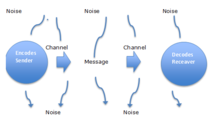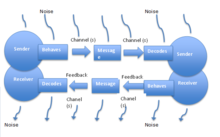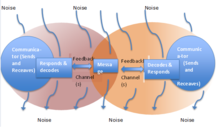- Models of communication
-
 A simple communication model with a sender transferring a message containing information to a receiver.
A simple communication model with a sender transferring a message containing information to a receiver.
There is an additional working definition of communication to consider[examples needed] that authors like Richard A. Lanham (2003) and as far back as Erving Goffman (1959) have highlighted. This is a progression from Lasswell’s attempt to define human communication through to this century and revolutionized into the constructionist model. Constructionists believe that the process of communication is in itself the only messages that exist. The packaging can not be separated from the social and historical context from which it arose, therefore the substance to look at in communication theory is style for Richard Lanham and the performance of self for Erving Goffman.
Lanham chose to view communication as the rival to the over encompassing use of CBS model (which pursued to further the transmission model). CBS model argues that clarity, brevity, and sincerity are the only purpose to prose discourse, therefore communication. Lanham wrote, “If words matter too, if the whole range of human motive is seen as animating prose discourse, then rhetoric analysis leads us to the essential questions about prose style” (Lanham 10). This is saying that rhetoric and style are fundamentally important; they are not errors to what we actually intend to transmit. The process which we construct and deconstruct meaning deserves analysis.
Erving Goffman sees the performance of self as the most important frame to understand communication. Goffman wrote, “What does seem to be required of the individual is that he learn enough pieces of expression to be able to ‘fill in’ and manage, more or less, any part that he is likely to be given” (Goffman 73) Goffman is highlighting the significance of expression. The truth in both cases is the articulation of the message and the package as one. The construction of the message from social and historical context is the seed as is the pre-existing message is for the transmission model. Therefore any look into communication theory should include the possibilities drafted by such great scholars as Richard A. Lanham and Erving Goffman that style and performance is the whole process.
Communication stands so deeply rooted in human behaviors and the structures of society that scholars have difficulty thinking of it while excluding social or behavioral events[weasel words]. Because communication theory remains a relatively young field of inquiry and integrates itself with other disciplines such as philosophy, psychology, and sociology, one probably cannot yet[update] expect a consensus conceptualization of communication across disciplines[weasel words].
Communication Model Terms as provided by Rothwell (11-15):
- Noise; interference with effective transmission and reception of a message.
- For example;
- physical noise or external noise which are environmental distractions such as poorly heated rooms, startling sounds, appearances of things, music playing some where else, and someone talking really loudly near you.
- physiological noise are biological influences that distract you from communicating competently such as sweaty palms, pounding heart, butterfly in the stomach, induced by speech anxiety, or feeling sick, exhausted at work, the ringing noise in your ear, being really hungry, and if you have a runny noise or a cough.
- psychological noise are the preconception bias and assumptions such as thinking someone who speaks like a valley girl is dumb, or someone from a foreign country can’t speak English well so you speak loudly and slowly to them.
- semantic noise are word choices that are confusing and distracting such as using the word tri-syllabic instead of three syllables.
- For example;
- Sender; the initiator and encoder of a message
- Receiver; the one that receives the message (the listener) and the decoder of a message
- Decode; translates the senders spoken idea/message into something the receiver understands by using their knowledge of language from personal experience.
- Encode; puts the idea into spoken language while putting their own meaning into the word/message.
- Channel; the medium through which the message travels such as through oral communication (radio, television, phone, in person) or written communication (letters, email, text messages)
- Feedback; the receivers verbal and nonverbal responses to a message such as a nod for understanding (nonverbal), a raised eyebrow for being confused (nonverbal), or asking a question to clarify the message (verbal).
- Message; the verbal and nonverbal components of language that is sent to the receiver by the sender which conveys an idea.
Linear Model – is a one way model to communicate with others. It consists of the sender encoding a message and channeling it to the receiver in the presence of noise. Draw backs – the linear model assumes that there is a clear cut beginning and end to communication. It also displays no feedback from the receiver.
- For example; a letter, email, text message, lecture.
Interactive Model – is two linear models stacked on top of each other. The sender channels a message to the receiver and the receiver then becomes the sender and channels a message to the original sender. This model has added feedback, indicates that communication is not a one way but a two way process. It also has “field of experience” which includes our cultural background, ethnicity geographic location, extend of travel, and general personal experiences accumulated over the course of your lifetime. Draw backs – there is feedback but it is not simultaneous.
- For example – instant messaging. The sender sends an IM to the receiver, then the original sender has to wait for the IM from the original receiver to react. Or a question/answer session where you just ask a question then you get an answer.
Transactional Model – assumes that people are connected through communication; they engage in transaction. Firstly, it recognizes that each of us is a sender-receiver, not merely a sender or a receiver. Secondly, it recognizes that communication affects all parties involved. So communication is fluid/simultaneous. This is how most conversation are like. The transactional model also contains ellipses that symbolize the communication environment (how you interpret the data that you are given). Where the ellipses meet is the most effect communication area because both communicators share the same meaning of the message.
- For example – talking/listening to friends. While your friend is talking you are constantly giving them feedback on what you think through your facial expression verbal feedback without necessarily stopping your friend from talking.
Contents
Communication Theory Framework
It is helpful to examine communication and communication theory through one of the following viewpoints[weasel words]:
- Mechanistic: This view[who?] considers communication as a perfect transaction of a message from the sender to the receiver. (as seen in the diagram above)
- Psychological: This view[who?] considers communication as the act of sending a message to a receiver, and the feelings and thoughts of the receiver upon interpreting the message.
- Social Constructionist (Symbolic Interactionist): This view} considers communication to be the product of the interactants sharing and creating meaning. The Constructionist View can also be defined as, how you say something determines what the message is. The Constructionist View assumes that “truth” and “ideas” are constructed or invented through the social process of communication. Robert T. Craig saw the Constructionist View or the constitutive view as it’s called in his article, as “…an ongoing process that symbolically forms and re-forms our personal identities.” (Craig, 125). The other view of communication, the Transmission Model, sees communication as robotic and computer-like. The Transmission Model sees communication as a way of sending or receiving messages and the perfection of that. But, the Constructionist View sees communications as, “…in human life, info does not behave as simply as bits in an electronic stream. In human life, information flow is far more like an electric current running from one landmine to another” (Lanham, 7). The Constructionist View is a more realistic view of communication[opinion] because it involves the interacting of human beings and the free sharing of thoughts and ideas. Daniel Chandler looks to prove that the Transmission Model is a lesser way of communicating by saying “The transmission model is not merely a gross over-simplification but a dangerously misleading representation of the nature of human communication” (Chandler, 2). Humans do not communicate simply as computers or robots so that’s why it’s essential to truly understand the Constructionist View of Communication well. We do not simply send facts and data to one another, but we take facts and data and they acquire meaning through the process of communication, or through interaction with others.
- Systemic: This view[who?] considers communication to be the new messages created via “through-put”, or what happens as the message is being interpreted and re-interpreted as it travels through people.
- Critical: This view considers communication as a source of power and oppression of individuals and social groups.[1]
Inspection of a particular theory on this level will provide a framework on the nature of communication as seen within the confines of that theory.
Theories can also be studied and organized according to the ontological, epistemological, and axiological framework imposed by the theorist.
Ontology essentially poses the question of what, exactly, it is the theorist is examining. One must consider the very nature of reality. The answer usually falls in one of three realms depending on whether the theorist sees the phenomena through the lens of a realist, nominalist, or social constructionist. Realist perspective views the world objectively, believing that there is a world outside of our own experience and cognitions. Nominalists see the world subjectively, claiming that everything outside of one’s cognitions is simply names and labels. Social constructionists straddle the fence between objective and subjective reality, claiming that reality is what we create together.[unbalanced opinion][neutrality is disputed]
Epistemology is an examination of how the theorist studies the chosen phenomena. In studying epistemology, particularly from a positivist perspective, objective knowledge is said[who?] to be the result of a systematic look at the causal relationships of phenomena. This knowledge is usually attained through use of the scientific method[neutrality is disputed]. Scholars often think[weasel words] that empirical evidence collected in an objective manner is most likely to reflect truth in the findings. Theories of this ilk are usually created to predict a phenomenon. Subjective theory holds that understanding is based on situated knowledge, typically found using interpretative methodology such as ethnography and also interviews. Subjective theories are typically developed to explain or understand phenomena in the social world.[citation needed]
Axiology is concerned with how values inform research and theory development.[2] Most communication theory is guided by one of three axiological approaches. The first approach recognizes that values will influence theorists' interests but suggests that those values must be set aside once actual research begins. Outside replication of research findings is particularly important in this approach to prevent individual researchers' values from contaminating their findings and interpretations.[3] The second approach rejects the idea that values can be eliminated from any stage of theory development. Within this approach, theorists do not try to divorce their values from inquiry. Instead, they remain mindful of their values so that they understand how those values contextualize, influence or skew their findings.[4] The third approach not only rejects the idea that values can be separated from research and theory, but rejects the idea that they should be separated. This approach is often adopted by critical theorists who believe that the role of communication theory is to identify oppression and produce social change. In this axiological approach, theorists embrace their values and work to reproduce those values in their research and theory development.[5]
Mapping the theoretical landscape
A discipline gets defined in large part by its theoretical structure[weasel words]. Communication studies often borrow theories from other social sciences[neutrality is disputed]. This theoretical variation makes it difficult to come to terms with the field as a whole[neutrality is disputed]. That said, some common taxonomies exist that serve to divide up the range of communication research. Two common mappings involve contexts and assumptions.
Contexts
Many authors and researchers[who?] divide communication by what they sometimes called "contexts" or "levels", but which more often represent institutional histories[neutrality is disputed]. The study of communication in the US, while occurring within departments of psychology, sociology, linguistics, and anthropology (among others), generally developed from schools of rhetoric and from schools of journalism. While many of these have become "departments of communication", they often retain their historical roots, adhering largely to theories from speech communication in the former case, and from mass media in the latter. The great divide between speech communication and mass communication becomes complicated by a number of smaller sub-areas of communication research, including intercultural and international communication, small group communication, communication technology, policy and legal studies of communication, telecommunication, and work done under a variety of other labels. Some of these departments take a largely social-scientific perspective, others tend more heavily toward the humanities, and still others gear themselves more toward production and professional preparation.
These "levels" of communication provide some way of grouping communication theories, but inevitably, some theories and concepts leak from one area to another, or fail to find a home at all.
The Constitutive Metamodel
Main article: Communication Theory as a FieldAnother way of dividing up the communication field emphasizes the assumptions that undergird particular theories, models, and approaches. Robert T. Craig suggests that the field of communication as a whole can be understood as several different traditions who have a specific view on communication. By showing the similarities and differences between these traditions, Craig argues that the different traditions will be able to engage each other in dialogue rather than ignore each other.[6] Craig proposes seven different traditions which are:
- Rhetorical: views communication as the practical art of discourse.[7]
- Semiotic: views communication as the mediation by signs.[8]
- Phenomenological: communication is the experience of dialogue with others.[9]
- Cybernetic: communication is the flow of information.[10]
- Socio-psychological: communication is the interaction of individuals.[11]
- Socio-cultural: communication is the production and reproduction of the social order.[12]
- Critical: communication is the process in which all assumptions can be challenged.[13]
Craig finds each of these clearly defined against the others, and remaining cohesive approaches to describing communicative behavior. As a taxonomic aid, these labels help to organize theory by its assumptions, and help researchers to understand why some theories may seem incommensurable.
While communication theorists very commonly use these two approaches, theorists decentralize the place of language and machines as communicative technologies. The idea (as argued by Vygotsky) of communication as the primary tool of a species defined by its tools remains on the outskirts of communication theory. It finds some representation in the Toronto School of communication theory (alternatively sometimes called medium theory) as represented by the work of Innis, McLuhan, and others. It seems that the ways in which individuals and groups use the technologies of communication — and in some cases are used by them — remain central to what communication researchers do. The ideas that surround this, and in particular the place of persuasion, remain constants across both the "traditions" and "levels" of communication theory.
Some realms of communication and their theories
- universal communication Law: Universal Theory, Dynamic-transactional Ansatz
- message production: Constructivist Theory, Action Assembly Theory
- message processing: Elaboration Likelihood Model, Inoculation theory
- discourse and interaction: Speech Acts Theory, Coordinated Management of Meaning
- developing relationships: Uncertainty Reduction Theory, Social Penetration Theory, Predicted Outcome Value Theory
- ongoing relationships: Relational Systems Theory, Relational Dialectics
- organizational: Structuration Theory, Unobtrusive and Concertive Control Theory
- small group: Functional Theory, Symbolic Convergence Theory
- media processing and effects: Social Cognitive Theory, Uses and Gratifications Theory
- media and society: Agenda Setting, Spiral of silence, Symbolic Convergence Theory
- culture: Speech Codes Theory, Face-saving Theory
- making social worlds: Coordinated Management of Meaning, Symbolic Interactionism
References
- ^ Littlejohn, S.W. and Foss, K.A. (2008). Theories of human communication, 9th edition. Belmont, CA: Thomson Wadsworth.
- ^ Miller, Katherine (2005). Communication Theories: Perspectives, Processes, and Contexts 2nd Edition. Boston, MA: McGraw-Hill Higher Education. ISBN 0072937947.
- ^ Miller (2005). pp. 30.
- ^ Miller (2005). pp. 30–31.
- ^ Miller (2005). pp. 31.
- ^ Craig, Robert T. (May 1999). "Communication Theory as a Field" (PDF). Communication Theory (Blackwell Publishing Ltd.; International Communication Association) 9 (2): 119–161. doi:10.1111/j.1468-2885.1999.tb00355. http://web4.uwindsor.ca/users/w/winter/40-328.nsf/bab13a777f84009f85256ea600759a11/10ff8b04ff3a317885256d88005720f6/$FILE/comm.theory.Craig.pdf. Retrieved Jan. 8, 2011.
- ^ Craig 1999, pp. 135-136.
- ^ Craig 1999, pp. 136-138.
- ^ Craig 1999, pp. 138-140.
- ^ Craig 1999, pp. 141-142.
- ^ Craig 1999, pp. 142-144.
- ^ Craig 1999, pp. 144-146.
- ^ Craig 1999, pp. 146-149.
Categories:- Communication
- Conceptual models
- Noise; interference with effective transmission and reception of a message.
Wikimedia Foundation. 2010.



